Keto Bread Recipes: Delicious and Easy Low-Carb Options
This post may contain affiliate links. If you purchase through these links, I may earn a small commission at no extra cost to you. LEARN MORE.
In the world of low-carb diets, finding a good bread substitute that meets keto requirements can be a challenge.
For those committed to a keto lifestyle, giving up bread might seem daunting, but it isn’t necessary.
Keto bread recipes offer delicious alternatives that are low in carbs yet full of flavor.
These recipes cater to everything from quick breakfasts to satisfying sandwich staples, ensuring that your keto diet doesn’t feel restrictive.
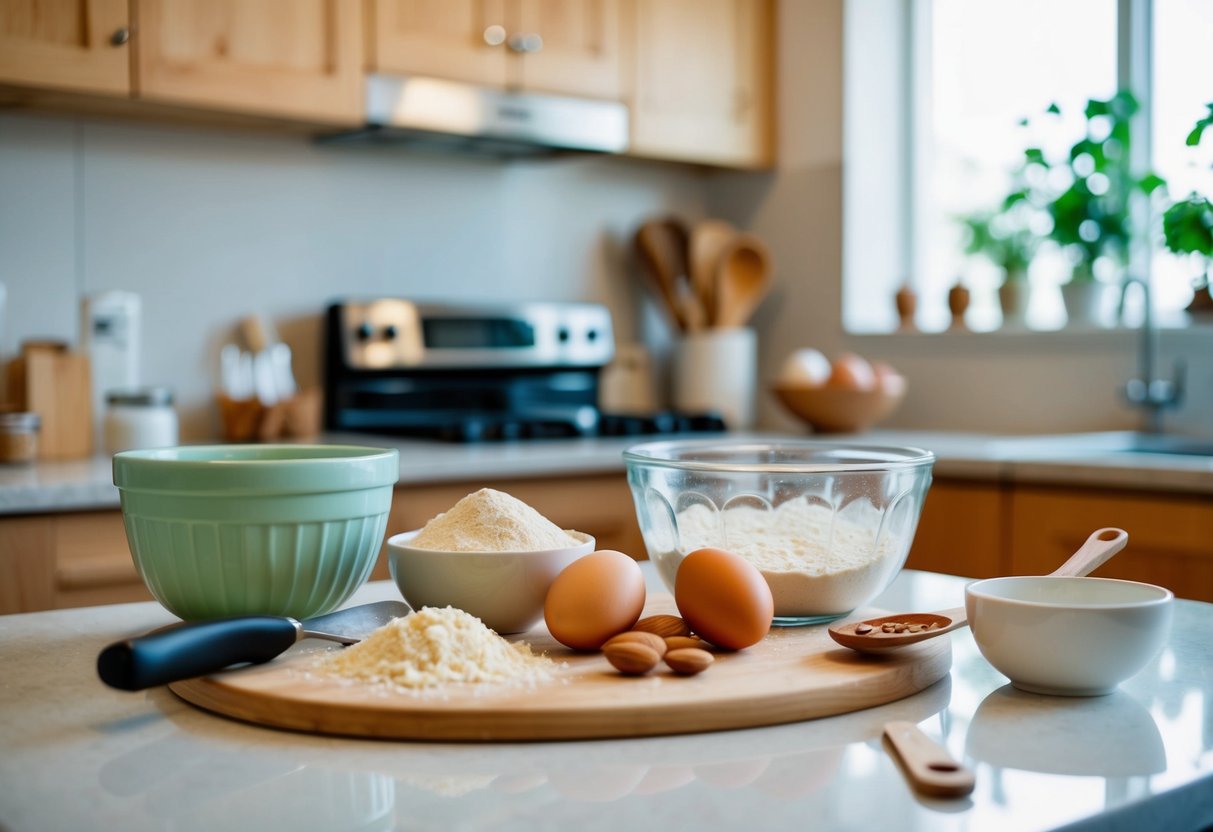
Keto bread is crafted to help manage carb intake while still allowing for a tasty bread experience.
Using almond flour and other low-carb ingredients, these breads maintain a pleasing texture and flavor that’s surprisingly close to traditional baked goods.
Whether you prefer a savory focaccia with olive oil or a sweet loaf that mimics a dessert, there are recipes available to satisfy a wide range of tastes.
To start baking keto bread, it’s important to get familiar with some basic techniques and ingredients.
As you explore more advanced keto baking, experimenting with different flavors and textures becomes exciting and rewarding.
Homemade keto bread can easily become a staple in your dieting routine, adding variety without sacrificing health goals.
New to keto? Start with our Custom Keto Diet Explained for Beginners guide
Key Takeaways
- Keto breads are low-carb and flavorful, suitable for keto diets.
- They use ingredients like almond flour to mimic traditional bread.
- A variety of recipes cater to different meals and tastes.
Understanding Keto Bread
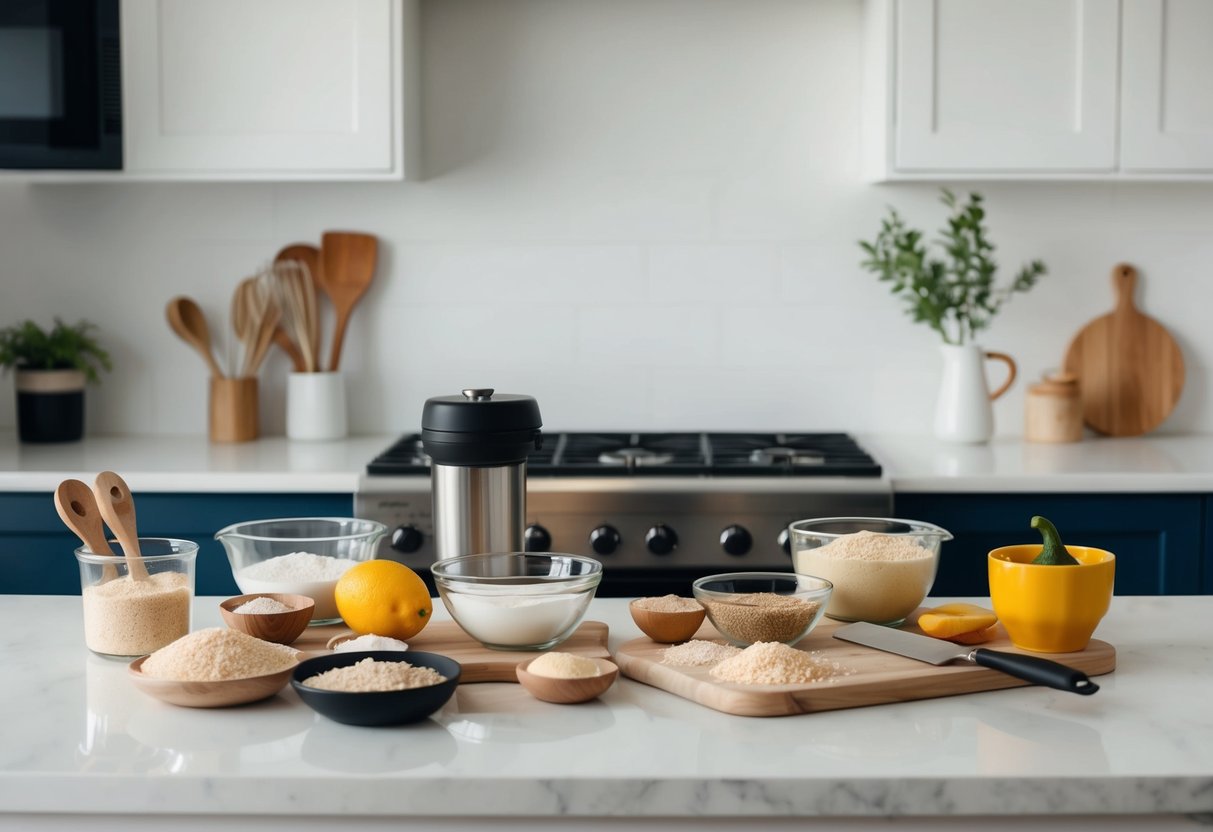
Keto bread is a popular choice for those following a keto diet. It is low in carbs and free from gluten, providing a healthy and tasty alternative to traditional bread.
Benefits of Keto Bread
Keto bread provides an excellent solution for those looking to reduce their carbohydrate intake.
One of the main benefits is its ability to help individuals stay in ketosis, which is essential for a keto diet.
By keeping carb levels low, keto bread helps to maintain the metabolic state where the body burns fat instead of glucose for energy.
Keto bread is also gluten-free, which is beneficial for individuals with gluten intolerance or celiac disease.
It offers a way to enjoy bread without the discomfort caused by gluten consumption.
Additionally, keto bread is often higher in fiber compared to regular bread, aiding in digestion and promoting a feeling of fullness.
Learn more about the science behind ketosis in our Keto Diet Explained for Beginners guide.
Keto-Friendly Ingredients
Keto-friendly bread relies on ingredients that keep carbs low while still delivering flavor and texture.
Common ingredients include almond flour and coconut flour, which replace traditional wheat flour.
These flours are low in carbs and rich in healthy fats, making them suitable for a keto diet.
Another key ingredient is psyllium husk, which adds fiber and structure to the bread.
Eggs are often used as a binding agent, providing moisture and protein.
Unsweetened almond milk or water serves as a liquid base, keeping the bread moist without adding carbs.
Some recipes incorporate seeds like flaxseeds or chia seeds, contributing to the nutritional value and texture of the bread.
Stock up on high-quality ingredients from Amazon for your keto baking needs.
Starting with the Basics

Learning to make delicious keto bread starts with understanding some key ingredients and how they work in low-carb baking.
This guide introduces almond flour, coconut flour, and psyllium husk bread recipes, which offer unique flavors and textures suited for a keto lifestyle.
Almond Flour Bread
Almond flour is a favorite for keto baking, offering a nutty flavor and soft texture.
Keto almond flour bread is lower in carbs than traditional bread, making it an excellent option for those watching their carb intake.
It’s versatile and can be used for sandwiches, toast, or as a side dish.
This bread is fairly easy to make. Mix almond flour with eggs, baking powder, and butter or oil.
A dash of salt can enhance taste, while using eggs as binders helps maintain a fluffy texture.
Almond flour is also rich in healthy fats and Vitamin E, adding nutritional value to each slice.
Check out our Keto Meal Prep Guide for more ideas and easy recipes.
Coconut Flour Bread
Coconut flour bread offers a subtly sweet taste, perfect for those who enjoy a hint of coconut flavor.
Coconut flour is low in carbs and high in fiber, making it a nutritious choice for keto baking.
It absorbs more liquid compared to other flours, meaning you’ll need more eggs or other liquids in your recipe.
To prepare keto coconut flour bread, it’s important to follow recipes closely to avoid a dry loaf.
Combining coconut flour with ingredients like eggs, butter, or coconut oil can create a moist, flavorful bread.
The fiber in coconut flour also helps improve digestion, providing another benefit to this baking choice.
Psyllium Husk Bread
Psyllium husk bread is known for its dense and hearty texture.
Psyllium husk powder aids in binding ingredients and can mimic the chewy texture of traditional bread.
For those on a keto diet, this bread can be a great substitute to enjoy without compromising on taste.
Making this bread involves mixing the psyllium husk powder with almond flour, eggs, and baking powder.
Adding boiling water helps activate the psyllium husk, creating a dough that holds together well.
The final result is a keto psyllium bread with a firm texture that works beautifully for sandwiches or as a side with meals.
Savory Keto Bread Variations
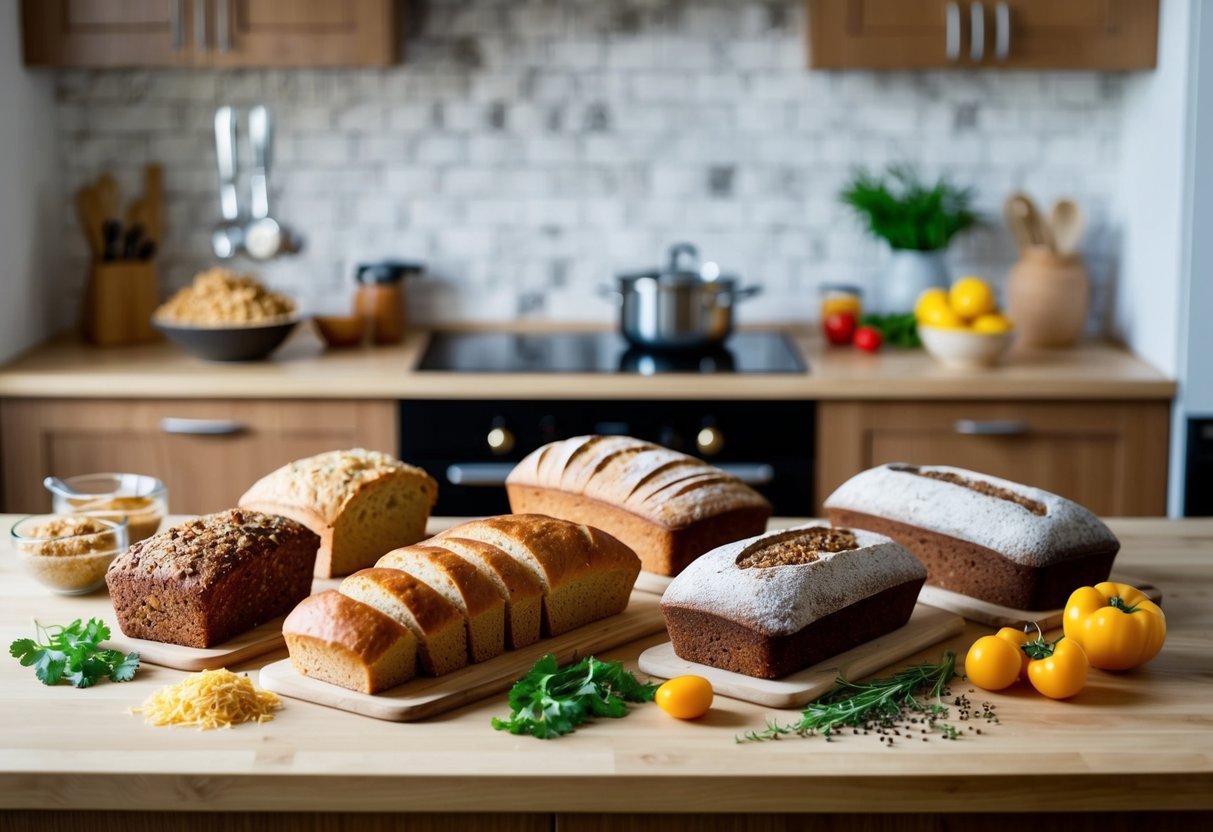
For those seeking flavorful low-carb options, savory keto bread offers a delightful solution. These variations provide a tasty way to enjoy bread without the carbohydrates. Read on for more about garlic breads, breads packed with seeds and nuts, and those featuring cheese and cauliflower.
Garlic Bread & Focaccia
Keto garlic bread is a delicious choice, featuring garlic and herbs for a flavorful bite.
By using almond flour and cheeses like mozzarella, this bread avoids carbs while delivering taste.
It’s a great side for keto-friendly pasta or salads.
Keto focaccia pairs olive oil with herbs, perfectly complementing soups or roasted meats.
This bread is typically soft inside with a crisp crust. Adding olives, sun-dried tomatoes, or rosemary enhances its flavor profile further, making it a versatile choice.
Pair this with our Keto Friendly Drinks to stay refreshed and in ketosis.
Seed & Nut Breads
Keto seed bread combines flaxseed, chia, or sunflower seeds, offering a crunchy texture and nutty taste.
High in fiber, these breads are not only low in carbs but also great for digestion.
They include almond or coconut flour to reduce carbohydrates without sacrificing flavor.
Nut breads incorporate walnuts, almonds, or pecans, adding richness.
These are protein-rich, making them a satisfying choice for breakfast or snacks.
Such breads are often moist, with a subtle sweetness that complements their savory taste.
Cheese & Cauliflower Breads
Keto cheese bread includes cheeses like parmesan or cheddar, bringing a rich and savory flavor.
With only a few ingredients, it’s easy to make and pairs well with soups or as a sandwich base.
These breads offer a delightful cheesy pull in every bite.
Cauliflower bread is another creative option, using grated cauliflower as a base.
Combined with eggs and mozzarella, it forms a low-carb alternative perfect for mini pizzas or sandwiches.
The bread is light yet flavorful, providing a unique substitute that stays within keto guidelines.
Sweet and Specialty Keto Breads
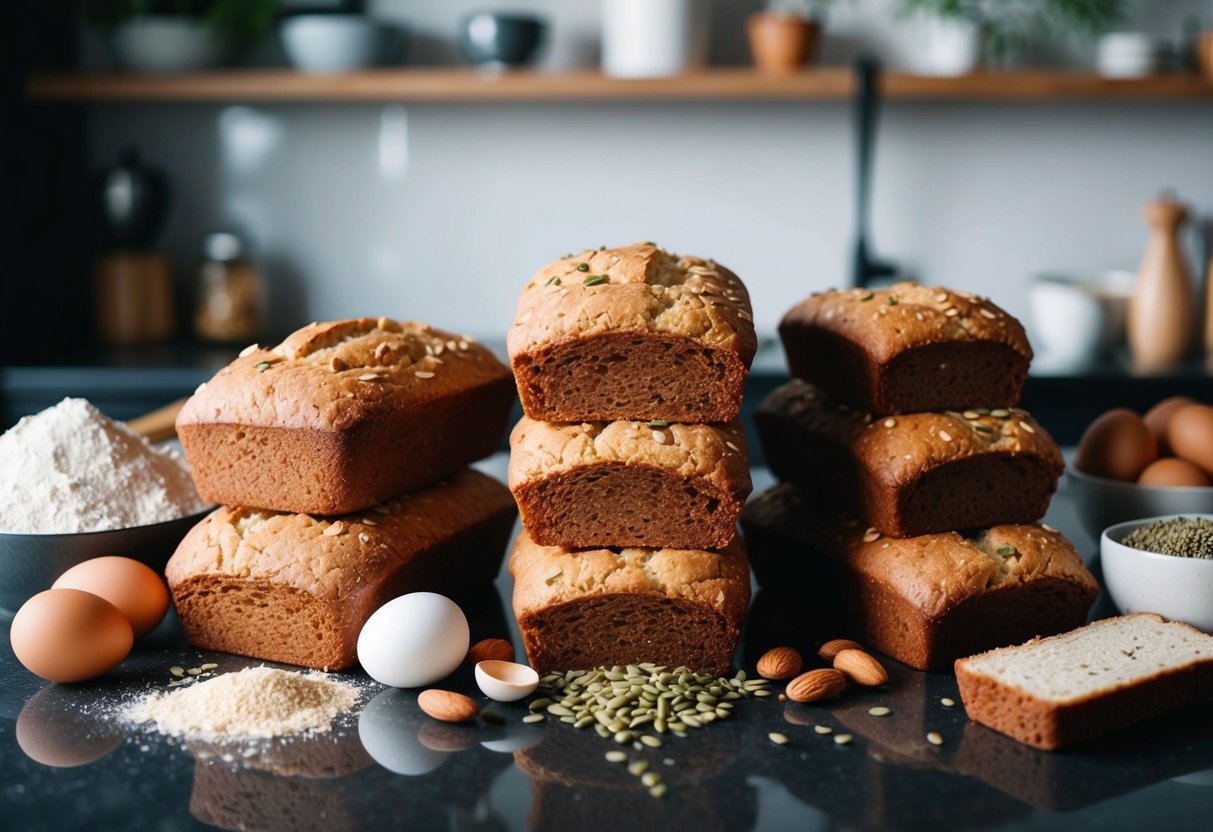
Sweet and specialty keto breads offer delightful and low-carb alternatives to traditional sugary loaves. From fruity creations to veggie-infused delights, these breads balance flavor and nutrition, fitting perfectly into a keto lifestyle.
Fruit Flavored Breads
Fruit flavored breads are a delicious way to enjoy sweet flavors while keeping carbs low.
Keto banana bread is a classic choice, using low-carb flours like almond or coconut and replacing regular sugar with a keto-friendly sweetener.
This bread captures the essence of ripe bananas without the usual carb load.
Blueberry bread is another popular option. It integrates juicy blueberries, which are low in sugar.
The recipe is often enhanced with vanilla extract and a touch of lemon zest to elevate the flavors.
Both varieties make excellent breakfasts or snacks, satisfying cravings without straying from keto guidelines.
Pumpkin & Zucchini Breads
Pumpkin and zucchini breads introduce unique flavors and textures to keto baking.
Keto pumpkin bread combines the warm spices of fall with the rich taste of pumpkin puree.
It’s subtly sweet, often sweetened with stevia or erythritol, and spiced with cinnamon and nutmeg.
Keto zucchini bread offers a more savory counterpart, though a bit of sweetness can be added.
The shredded zucchini keeps the bread moist while ensuring a nutritious touch.
Both breads are versatile, pairing well with a spread of cream cheese or butter, making them excellent for both breakfast and dessert options.
Love baking? Try our Keto Dessert Recipes for more treats!
Keto Breads for Every Meal
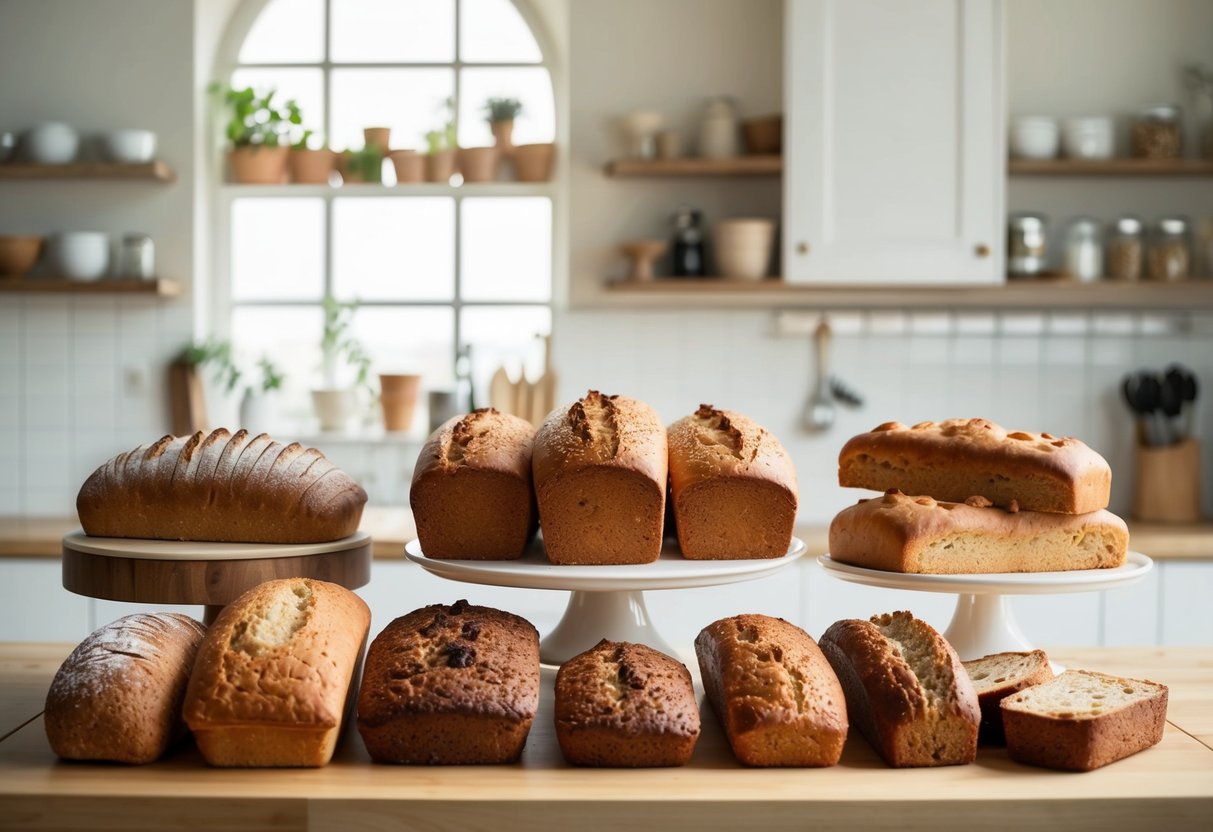
Keto breads are versatile and can fit seamlessly into any meal of the day.
Whether starting with breakfast, pairing with dinner, or snacking in between, there are delicious low-carb options available. These breads support various keto meals and ensure you stay low-carb throughout your day.
Breakfast Options
Starting the day with keto breakfast breads can make mornings more enjoyable.
Cheesy almond flour breads, for instance, offer flavor and warmth. A popular choice is the 90-second mug bread, which is quick to prepare and perfect for spreading butter or avocado.
For those who love something sweet, cottage cheese pumpkin loaves fit perfectly.
They pair well with coffee or tea and can be made in advance to save time on busy mornings.
These breads are not just filling but also help maintain energy levels without spiking blood sugar.
Dinner Companions
Keto dinner rolls and buns make excellent companions for evening meals.
These gluten-free options often use almond or coconut flour, giving them a satisfyingly soft texture.
Keto garlic bread is a favorite choice, complementing soups, salads, or main dishes with its rich flavor.
For those who enjoy a Mediterranean twist, Keto Rosemary Focaccia is an ideal match.
It’s flavored with herbs like rosemary and includes olives for an extra punch.
Such breads are versatile and can make any keto meal idea more complete and satisfying.
Snackable Bites
Between meal cravings are easily tackled with low-carb snack breads.
Keto breadsticks, which are often made with cheese or seed mixtures, provide a crunchy texture and are handy for on-the-go snacks.
They’re an ideal option for anyone needing a quick bite without derailing their diet.
Another great snack is zero-carb bread, delivering the savory taste of traditional bread without the carbs.
Perfect for dipping in olive oil or pairing with low-carb spreads, these breads hit the spot without affecting ketosis.
With such variety, satisfying hunger between main meals is simple and delicious.
Whether you’re looking for a hearty breakfast start, a satisfying dinner companion, or a quick, on-the-go snack, check out our Keto Breakfast Recipes, Keto Dinner Bread Ideas, and Keto Snack Recipes for inspiring low-carb options
Advanced Keto Baking Techniques
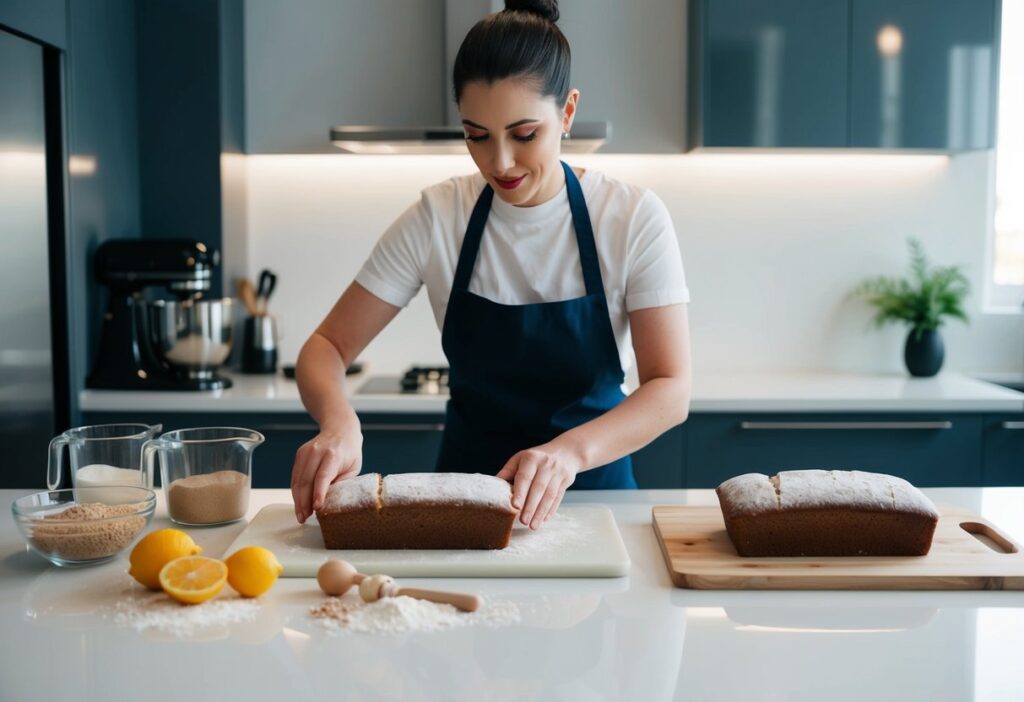
When mastering keto baking, attention to detail in texture and flavor is crucial.
Effective ingredient swaps and clever tips can enhance the health benefits of your low-carb creations.
Perfecting Texture and Flavor
Achieving the right texture in keto bread requires balancing moisture and dryness.
Almond flour and coconut flour often provide a nutty flavor and are rich in healthy fats.
It’s important to understand that these flours absorb more liquid than regular flour.
Adding extra eggs or psyllium husk can help maintain a moist crumb while creating a fluffy loaf.
Baking soda and baking powder are essential to achieve rise and fluffiness.
Experimenting with spices or extracts, like cinnamon or vanilla, introduces unique flavors without increasing carbs.
Keto Baking Swaps and Tips
Relying on keto-friendly ingredients is key to successful swaps.
Sweeteners like erythritol or monk fruit are popular choices, offering sweetness without blood sugar spikes.
Instead of milk, opt for almond milk or coconut milk to add creaminess and moisture.
Using parchment paper keeps loaves from sticking and simplifies cleanup.
Storing keto bread properly ensures it stays fresh; airtight containers retain moisture, while refrigeration preserves quality.
Utilizing these keto baking tools and tips will improve baking outcomes, making advanced keto recipes both achievable and enjoyable.
Tips for Storing and Troubleshooting Your Keto Bread
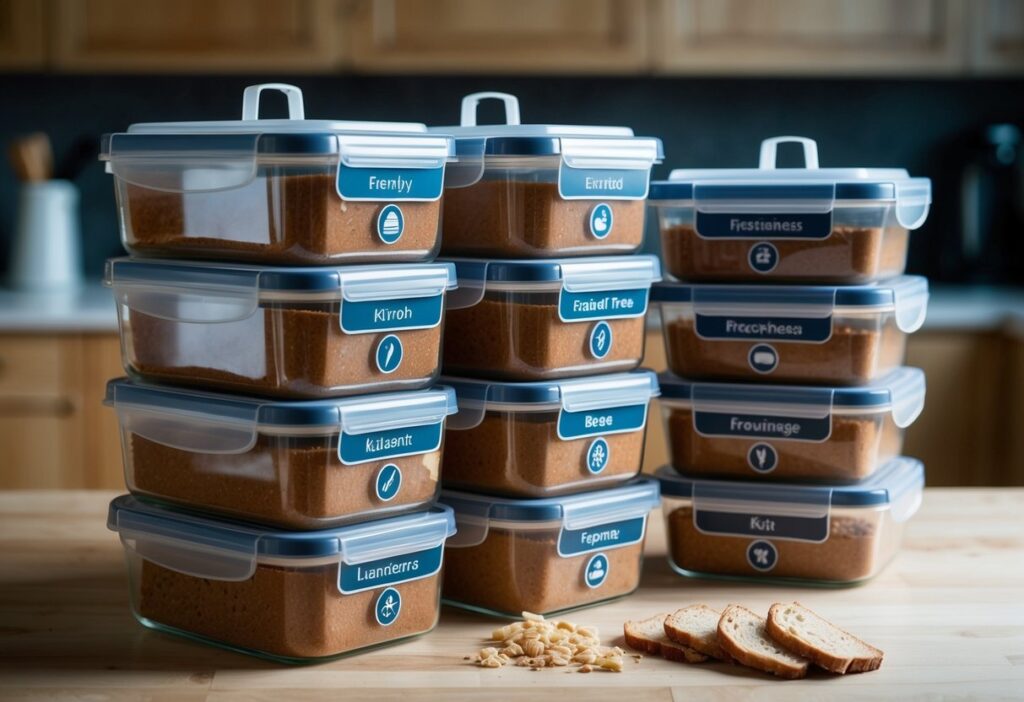
Keeping keto bread fresh can be tricky, but using the right storage methods helps preserve its taste and texture.
Addressing common baking issues ensures your low-carb loaf turns out perfectly every time.
Best Practices for Storage and Reheating
To extend the shelf life of keto bread, it is best to store it in the refrigerator. This keeps it fresh for up to two weeks.
Wrapping the bread in a cloth or paper before placing it in the fridge will help prevent it from drying out.
Avoid storing keto bread in the fridge door; it’s too warm there, which can spoil the bread more quickly.
When longer storage is needed, freezing is an excellent option.
Place slices in a freezer-safe container or bag to prevent freezer burn.
When reheating, use a toaster to bring back the fresh texture. Avoid microwaves, as they can make the bread soggy.
Troubleshooting Common Baking Problems
Baking keto bread can have its challenges. Sometimes the bread can collapse or not rise properly. This could be due to expired ingredients or not measuring them correctly.
Always ensure baking powder and yeast (if used) are fresh and measured accurately.
Excess moisture can be another common issue. If the bread turns out too dense or wet, try reducing the amount of liquid ingredients.
It’s also helpful to check the baking time and temperature; adjustments might be necessary based on your oven’s performance.
Testing with a toothpick can indicate if the inside is thoroughly baked.
Want to stay on track? Read our Keto Meal Planning Guide.
Frequently Asked Questions
Keto bread recipes are a popular choice for those looking to maintain low-carb diets. This section addresses common queries about easy recipes, suitable ingredients, and maintaining nutritional balance with keto bread.
What are the simplest keto bread recipes for daily baking?
Some of the simplest keto bread recipes use five ingredients or less. These quick recipes often include ingredients like almond flour, eggs, baking powder, and butter. They are easy to prepare and can be ready in under an hour.
Can I make keto bread without almond flour?
Yes, keto bread can be made without almond flour. Alternatives include coconut flour, flaxseed meal, or psyllium husk powder. These ingredients help maintain a low-carb profile while providing a satisfying texture.
How do you make low carb bread suitable for diabetics?
To make low carb bread suitable for diabetics, focus on ingredients with a low glycemic index. Almond flour, coconut flour, and eggs are good choices.
Avoid sweeteners that may cause blood sugar spikes and monitor portion sizes to manage carb intake effectively.
Is it possible to use yeast in keto bread recipes?
Using yeast in keto bread recipes is possible. While yeast feeds on sugar, using just enough to activate it won’t significantly increase carbs.
Combining yeast with low-carb flours can give keto bread a more traditional texture and flavor.
What can be used as a bread alternative in a keto diet?
For those on a keto diet, bread alternatives include lettuce wraps, cloud bread, and portobello mushroom caps. These options keep the focus on low carbs while still providing a structure for sandwiches and toppings.
Is consuming keto bread every day recommended for maintaining ketosis?
Eating keto bread every day can fit into a keto diet as long as overall carb intake is monitored.
It’s important to balance daily meals and snacks to ensure that they all collectively stay within keto-friendly carb limits.
Conclusion
Keto bread recipes make it easier to enjoy a low-carb lifestyle without missing out on comfort foods.
From chewy bagels to moist cornbread, there are options for every meal.
These recipes stay true to the principles of the keto diet by being low in carbs and high in healthy fats.
This balance can help maintain ketosis, which is key for those following this diet.
The variety of flavors and textures in keto bread options helps ensure that anyone can find a favorite.
Whether it’s a light and fluffy loaf for sandwiches or a hearty rosemary focaccia with soup, there’s a bread for every occasion.
For those who love to bake, creating keto bread at home is both rewarding and satisfying.
The ingredients are straightforward, and many recipes can be made in less than an hour.
With the right ingredients, keto bread provides the taste and texture of traditional bread.
These recipes allow individuals to enjoy bread-like foods while sticking to low-carb eating habits.
Get started with keto diet today! Try our custom keto diet to personalized your meal for 8 weeks.









